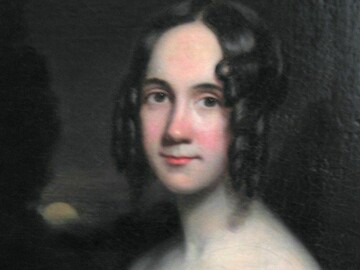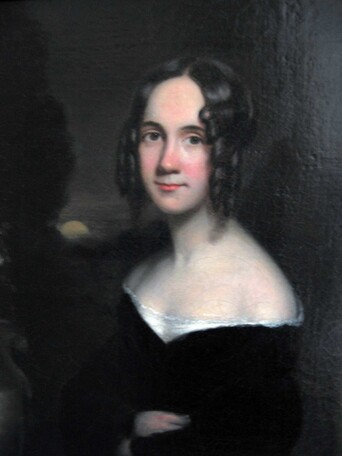Sarah Josepha Hale
- Date
- c.1831
- Material
- Oil on Canvas
- Author/Maker
- James Reid Lambbdin (1807 - 1889)
- Source
- Image courtesy of the Richard’s Free Library, Newport New Hampshire

Image courtesy of the Richard’s Free Library, Newport New Hampshire
Description
In the 1830s, New Englanders looked back at the Pilgrims’ harvest feast and began to refer to it as the “First Thanksgiving” because there were so many similarities between it and their own holiday - which featured morning church services, family reunions, sports, and turkey with all the trimmings. Born in Newport, New Hampshire in 1788, Sarah Josepha Hale was a strong proponent of both female education and prescribed gender roles for women, she supported herself and her family through her writing, advocating for the proper domestic sphere for women, the establishment of a national Thanksgiving holiday, and the abolition of slavery. In 1837, Hale became a writer and later editor (or editress, as she preferred) of Godey’s Lady’s Book, a post she would hold until 1877. Its wide readership made her one of the most influential voices in the country throughout most of the 19th century. These excerpts demonstrate how she used her skill as a writer to disseminate information about and build interest in the New England Thanksgiving traditions across the country.
Starting in the 1830s, Hale used her platform to campaign for Thanksgiving as an official holiday by petitioning several governors and succeeding US Presidents to make it an annual event. In 1863, President Abraham Lincoln responded to Hale’s campaign and set a longstanding tradition when he declared a Thanksgiving for the last Thursday in November. That day would continue to be set aside by presidents every year from 1864 - 1939 when President Franklin Delano Roosevelt moved the holiday back a week to extend the Christmas shopping season. In 1941, Congress passed a law that permanently established Thanksgiving on the fourth Thursday of November.
Transcription
Northwood; Or, Life North and South Showing the True Character of Both (1852)
“The roasted turkey took precedence on this occasion, being placed at the head of the table; and well did it become its lordly station, sending forth the rich odor of its savory stuffing, and finely covered with the froth of the basting...There was a huge plum pudding, custards and pies of every name and description ever known in Yankee land; yet the pumpkin pie occupied the most distinguished niche.”1
Godey’s Lady’s Book and Magazine Editorials
1848
“Thanksgiving Day - The observance of this hallowed day is another strong link in the chain that binds the states in brotherhood. We are more than glad, we are grateful that the suggestion, emanating from our ‘Lady’s Books’ has been so kindly received. We suggested, early last year, that the Day of Thanksgiving should be observed on the last Thursday in November, throughout the nation. Of course, the appointment of the day rests with the governors of each state; and hitherto, though the day of the week was always Thursday, that of the months has been varied. But the last Thursday of last November was kept as Thanksgiving Day in twenty-four of the twenty-nine states - all that kept such a feast at all. May the last Thursday of the next November witness this glad and glorious festival, this ‘feast of the ingathering of harvest,’ extended over our whole land, from the St. Johns to the Rio Grande, from the Plymouth Rock to the Sunset Sea.”2
1855
THANKSGIVING DAY.--When shall it be? The last Thursday in November falls on the 29th. We petition each and all the State governors to appoint that day for our national rejoicing. Then all the land will be glad together, and union among the people would be a sure pledge of heart-thankfulness to God, who has given to us, as a nation, such wonderful prosperity, such universal blessings. The readers and friends of the "Lady's Book," that is, a large majority of the people of these United States, agree in our petition. Let us have a national day of Thanksgiving on Thursday, the 19th of November.3
1860
“Everything that contributes to bind us in one vast empire together, to quicken the sympathy that makes us feel from the icy North to the sunny South that we are one family, each a member of a great and free Nation, not merely the unit of a remote locality, is worthy of being cherished. We have sought to reawaken and increase this sympathy, believing that the fine filaments of the affections are stronger than laws to keep the Union of our States sacred in the hearts of our people… We believe our Thanksgiving Day, if fixed and perpetuated, will be a great and sanctifying promoter of this national spirit."4
Letter from Hale to Abraham Lincoln, September 28, 1863
Library of Congress, Manuscript Division, Abraham Lincoln Papers.
“ [A] day of our annual Thanksgiving made a National and fixed Union Festival…You may have observed that, for some years past, there has been an increasing interest felt in our land to have the Thanksgiving held on the same day, in all the States; it now needs National recognition and authoritive fixation, only, to become permanently, an American custom and institution."5
Media

Image courtesy of the Richard’s Free Library, Newport New Hampshire
Discussion Questions
-
What do these three accounts of harvest celebrations have in common?
-
How did Thanksgiving change from a New England holiday to a national holiday? Why do you think this was important to advocates like Sarah Josepha Hale?
-
How did Sarah Josepha Hale use Godey’s Lady's Book as a platform to advocate for her beliefs? What are some examples of this kind of activism today?
Footnotes
- 1Northwood provides one of the earliest descriptions of the Thanksgiving feast table, noting particularly the turkey and pumpkin pie. Sarah Josepha Hale, Northwood; Or, Life North and South Showing the True Character of Both (New York: H. Long & Brother, 1852) pg. 89
- 2 Sarah Josepha Hale: Editor’s Table, Godey’s Lady’s Book and MagazineVol. 36:3 (Philadelphia, 1848) pg. 127. Accessed 9/15/23.
- 3 Sarah Josepha Hale: Editor’s Table, Godey’s Lady’s Book and Magazine Vol. LI. (Philadelphia, July 1855) pg. 373 accessed 4/26/23
- 4Sarah Josepha Hale: Editor’s Table, Godey’s Lady’s Book and Magazine Vol. 60 (Philadelphia, July1860) pg. 175. Accessed 10/6/23.
- 5Lincoln, Abraham. Abraham Lincoln papers: Series 1. General Correspondence. 1833 to 1916: Sarah J. Hale to Abraham Lincoln, Monday,Thanksgiving. 1863. Manuscript/Mixed Material.